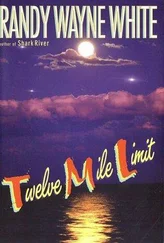Randy White - Night Vision
Здесь есть возможность читать онлайн «Randy White - Night Vision» весь текст электронной книги совершенно бесплатно (целиком полную версию без сокращений). В некоторых случаях можно слушать аудио, скачать через торрент в формате fb2 и присутствует краткое содержание. Жанр: Триллер, на английском языке. Описание произведения, (предисловие) а так же отзывы посетителей доступны на портале библиотеки ЛибКат.
- Название:Night Vision
- Автор:
- Жанр:
- Год:неизвестен
- ISBN:нет данных
- Рейтинг книги:5 / 5. Голосов: 1
-
Избранное:Добавить в избранное
- Отзывы:
-
Ваша оценка:
- 100
- 1
- 2
- 3
- 4
- 5
Night Vision: краткое содержание, описание и аннотация
Предлагаем к чтению аннотацию, описание, краткое содержание или предисловие (зависит от того, что написал сам автор книги «Night Vision»). Если вы не нашли необходимую информацию о книге — напишите в комментариях, мы постараемся отыскать её.
Night Vision — читать онлайн бесплатно полную книгу (весь текст) целиком
Ниже представлен текст книги, разбитый по страницам. Система сохранения места последней прочитанной страницы, позволяет с удобством читать онлайн бесплатно книгу «Night Vision», без необходимости каждый раз заново искать на чём Вы остановились. Поставьте закладку, и сможете в любой момент перейти на страницу, на которой закончили чтение.
Интервал:
Закладка:
I replied, “Sure. Everyone does,” because I thought it might make her feel better or reassure her at the very least.
I had underestimated the Guatemalan girl’s strength, however, and her maturity. It was Tula who then provided me with a more tangible form of reassurance, saying, “That doesn’t mean warriors shouldn’t lie to protect other warriors. Joan of Arc did it many times to protect her knights. The Maiden has promised me it’s true-Dr. Ford.”
EPILOGUE
On the second Sunday in March, which is when daylight savings adds an hour of light to winter’s darkness, I drove my truck to the West Wind Inn, a mile from Dinkin’s Bay, and was on the beach in time to watch the sunrise.
It was 6:43 a.m. The sun had not yet appeared above the Sanibel Lighthouse, but clouds to the west were fire laced, tinged with pink and edged with turquoise from a sky that melded blue with the green of an old morning sea.
I had just taken possession of a custom surfboard, designed by surf icon Steve Brom and shipped from the Florida Panhandle by YOLO Boards of Santa Rosa Beach.
It was Tomlinson who had discovered the fledgling company, perhaps charmed by the YOLO acronym: You Only Live Once.
As my friend pointed out, the name didn’t mesh with his convictions about reincarnation or life after death, but, as he explained, “You gotta love the kick-ass spirit it represents.”
I was unmoved until I had tried one. The next afternoon, I spoke to Brom and ordered a board specifically for my needs. After discussing what I wanted, I then provided the man with my height and weight.
Amused, the California surf guru had told me, “I don’t expect to see you on the pro circuit anytime soon. But this might be my chance to create a board that even a gorilla could use, maybe even learn to shred.”
Funny guy.
The board-a stand-up paddleboard, by definition-had arrived yesterday, a Saturday, just as I had finished separating a new batch of specimens, sea horses and filefish in one tank, two dozen anemones in another. After I had unboxed the board, I had leaned it against the outside wall of my lab, then trotted down the steps to get a better view from the deck.
There is something iconic about the shape of a surfboard. It gave me pleasure just looking at it. The body was laminated bamboo, rails classically arched, the bottom painted deuce-coupe yellow. The board was more than eleven feet long, the ends symmetrically rounded, and I amused myself by deciding it would have appeared equally at home on Easter Island, guarding a seaward bluff, or sliding down a North Shore wave.
Waves. That’s why I had come to the beach. It’s why I had done only an abbreviated morning workout, then headed straight to the West Wind after checking the weather report.
Sanibel Island isn’t known for its surf, but this morning was different. Wind was blowing low over the Gulf, rolling waves from the southwest, their crests finally peaking as they soldiered toward the beach after a five-hundred-mile journey from the Yucatan, Mexico.
Just beyond the second sandbar, fifty yards from shore, a translucent green beach break was curling with a symmetry so consistent that I realized my hands were shaking a little as I strapped the leash around my ankle, then carried the board to the water.
To my left, to my right, there were early-morning beach strollers and shellers and young honeymooners walking hand in hand. Decade after decade on the islands, the faces differ, but the beaches continue to provide a safe conduit to the infinite, narrow galleries of sand that illustrate relentless change.
The surf line, though, was as empty as the horizon.
Waves were waiting. And so was something else I needed: solitude. I craved it. Craved it so intensely that, since I had rescued the Guatemalan girl eleven days earlier, I had been avoiding people. It is the same when I return from an overseas assignment. I view it as decompression time, a period of slow reacclimatization after surfacing from the depths.
At the gate to my boardwalk, I had hung the NO VISITORS PLEASE sign. I retreated to my lab, ignoring e-mails, refusing phone calls, and I had even skipped Dinkin’s Bay Marina’s traditional Fridaynight party.
I worked out every morning and afternoon, then spent most of the day in my flats skiff or in my little trawler, dragging nets. My only companions were the sea creatures that inhabited my aquaria, my telescope and the marina’s self-important cat, Crunch amp; Des, who spent an unusual amount of time gifting me with an unusual amount of attention.
Two people I made a special effort to avoid were Tomlinson and Emily Marston.
The only person I spoke with daily-almost daily, anyway-and visited whenever I could, was Tula Choimha. I had wrestled with the possibility that interacting with the girl might cause police to be suspicious. As I got to know her better, however, and because I paid close attention to how law enforcement types reacted when I was around, I was soon convinced that the opposite was true.
More important, I was convinced of something more compelling: Tula could be trusted. We never discussed what had happened. The girl was savvy enough to understand that any mention of that night could mean years in jail for me.
Instead, we spoke of her brother and her aunts and how eager she was to return to Guatemala. Her mother, though, was never mentioned. I didn’t pry because of something Tula had shared with me that night during our long drive. “My mother is dead,” the girl told me. After several minutes of silence, she explained, “Harris confessed something to me that I can never speak of again. I love them both and I forgive them both. Because I love them, the truth of how my mother died will die with me.”
A safer topic for our daily talks included the hundreds of Central Americans who visited the girl’s hospital daily, waiting patiently and offering prayers, even though they knew they would not be allowed to see the patient they revered.
It required special patience for me to pretend to accept Tula’s explanation. “They’re aware that God has sent them a message through me. My people don’t belong here. No amount of money is worth the homes and families they abandoned. On their cell phones, I know they probably exaggerate what I suffered-some of the crazy stories the nurses have told me! But the fire was real, and so was the evil. God wants me to keep spreading His message. And I will.”
What transpired the night I rescued Tula was on my mind hour after hour, day after day. From it sprouted additional worries and realizations. I had saved the girl. It made me responsible for her in some ways. I also felt a growing affection for Tula that was beyond anything I had anticipated. It matched my admiration for Tula’s intellect, her maturity and her decency.
In the bag I had taken from Squires’s truck, I had counted out more than fifty-three thousand, mostly in hundreds, fifties and twenties. Cash of that amount would invite scrutiny, and I was still investigating the best way to create an account in Tula Choimha’s name.
Responsibility is a petri dish of worry.
But now as I waded into the Gulf, then paddled toward the surf line, my earth-linked worries faded, becoming incrementally smaller with every freeing stroke.
Nine days after the missing Guatemalan girl made headlines by suddenly reappearing at Red Citrus RV Park dazed and injured, she was released from the hospital with the blessings of the Florida Department of Law Enforcement, but only after several interrogation sessions plus four days of medical tests and psychological evaluations.
“The child is suffering from shock and what may be posttraumatic amnesia,” a department spokesman was quoted as saying. “But she is a resilient child, very brave, and the information she has provided is so detailed that we believe we have a firm grasp on the facts regarding how she disappeared and the murders she may have witnessed.”
Читать дальшеИнтервал:
Закладка:
Похожие книги на «Night Vision»
Представляем Вашему вниманию похожие книги на «Night Vision» списком для выбора. Мы отобрали схожую по названию и смыслу литературу в надежде предоставить читателям больше вариантов отыскать новые, интересные, ещё непрочитанные произведения.
Обсуждение, отзывы о книге «Night Vision» и просто собственные мнения читателей. Оставьте ваши комментарии, напишите, что Вы думаете о произведении, его смысле или главных героях. Укажите что конкретно понравилось, а что нет, и почему Вы так считаете.












